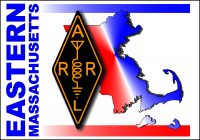Contents
Introduction
While Field Day is officially an “Operating Event” and not a “Contest,” we still have “Points” to score.
Clubs and ARES teams operating in Field Day can collect points for making contacts of course, same as any Contest. But there are some points specifically available for ARES/NTS/RACES related activities at Field Day.
Specific rules and points vary from year to year, so check the annual Field Day rules download, usually available early in the new year at http://www.arrl.org/contest-rules. Look for the “Bonus Points” section and see what is on offer this year. Some Bonuses are available to all stations, others only to Club and EOC stations, others to those on specific kinds of emergency or natural power.
Contacts and “Multipliers”
The basic points are the count of stations contacted, per band, per mode, multiplied by “the Multipliers.” Multipliers are a common concept in Contesting but for the casual conversationalist or public-service operator: Multipliers are conditions which increase the points per contact by a multiple.
Bands – So the first way to get multiple points for a near-by, easy to work station is to plan to work then on every band open on the day.
Modes – And then recontact them on each of Voice, Morse/CW, and Digital text. (Note: all voice modes are considered equivalent. On HF below 10m, this isn’t an issue, since we wouldn’t use AM for efficient context or emergency operation, so it’s SSB. (But it’s important to remember that at 10m and up, FM Voice and SSB voice count the same and would be duplicates if the same station is worked both ways.) Likewise all non CW/Morse digital contacts are considered a single mode for contest and duplicate purposes — working the same remote station on both PSK31 and RTTY on the same band would dup, but on different bands would be OK. (Contest Branch will probably have to rule how simplex digital voice counts, as that should have good range, but is it Voice or Digital?)
(Providing positive control of count of Transmitters and simultaneous band use is the subject of a separate article.)
Traditionally, Morse Code (“CW”) contacts count 2x in a context compared to Voice contacts because they take longer to make. (No, not because the whitebeards value them more, this dates from before the Code Wars.) Modern Digital has also been a 2x multiplier to encourage its use, and as it can be slow if hand typed. So adding some Digital modes to your Field Day stations is good too.
Power The other Multiplier is the Power Multiplier. Stations operating at medium or low power are rewarded by scoring more points per contact, compared to the QRO home stations with the max legal linear amp. (Typically, 1x for power > 150W; 2x for upto 150W; and 5x for upto 5W., but check the annual rules and score sheet for latest.)
One point of advice: Do any Bonus contacts such as “Alternate/Solar/Natural Power” contacts early in the operating period, as your site’s regular, likely higher power stations will work the strongest nearby stations fairly quickly as they open each band, and a Duplicate contact on same Band/Mode likely won’t count, so “have dessert first”. A Satellite QSO isn’t as urgent, as long as a single satellite station is a Free station and treated as a separate band. They count as QSOs normally as an extra band and a big bonus for doing at least one! (Note: Must be Earth-Sat-Earth exchange, not just a packet download. Limit one QSO per single-channel FM sat to avoid congestion.)
Move them Up – HF stations and VHF stations should have easy reference to a list of what other bands and modes are (a) being worked now and (b) possible at this site, in case a station contacted asks — and if they’re not in a hurry, you can ask them what else they have, and refer them.
VHF+ Agility If your VHF+ station has a multiband multimode radio and antennae, you can move a 2m FM/SSB contact down to 6m SSB/CW/FM and up to 440 SSB/CW/FM, and where else both stations have available. Just be sure you don’t have two stations on FM and SSB on the same band at once!
(Remember, no points for repeater contacts. Check detailed rules for “spotting” and “sked” rules.)
How many bands can you support? If there are 900MHz or 1.2GHz repeaters in the area, the mobile rigs and HTs can also be used for Simplex for Field Day. If you set up a good antenna and base, other nearby hilltop stations will be able to work you. If a really good hilltop, get that one club member that does the microwave contest to bring the 2.4/5/10 GHz hilltopping kit, and plan to meet other microwave-capable hilltop clubs on e.g. 440 SSB or FM Calling.
NTS Traffic Handling
One of the usual activities at Field Day involves exercising formal message handling skills for both ARRL and ARES liaison, using the National Traffic System (NTS) formal message format. The NTS team shared a post in 2018 on that, which has been adapted into an ongoing article “Field Day Traffic Tips“; and do check for newer posts.
Section FD Message(s) – This has typically included originating a message from the FD site to the ARRL Section Manager (SM) and/or to the ARRL ARES Section Emergency Coordinator (SEC) noting your location, number of participants, and number of ARES-enrolled operators attending.
Handling – Some years, there are additional points available for “handling” formal traffic (other than your station’s SM/SEC message above) — this can be originating third party greetings traffic from visitors, or relaying traffic from one NTS net to another NTS net, or delivering messages to the final recipient. This is particularly easy if the SM or SEC is visiting your site at net time: collect their messages for them from the NTS Net and hand them a stack of hard copy!
(Note that the above messages must enter and leave the Field Day site on Amateur Radio Radio-frequency — Internet access to the NTS Bulletin Board via commercial provider does not count.)
W1AW Bulletin – Another kind of message handling is copying a bulletin transmitted by W1AW (and K6KPH west-coast) as a “Code Practice” and reception test bulletin. The transmission schedule will be in the annual information packet. Copy (transcribe) the bulletin off-air and provide a copy with your scores packet.
ARES & PIO Functions
Various things your club’s Amateur Radio Emergency Services team would practice in a Simulated Emergency Test are valuable to Field Day as a more public demonstration of emergency capability too, and thus in the gamification of the Operating Event as a quasi Contest, are awarded points.
Organizing the Field Day committee for both planning and execution according to the National Incident Management Standard (NIMS) will allow the ARES team to practice their training and nomenclature between Public Service events and may remind the committee of things that need to be covered).
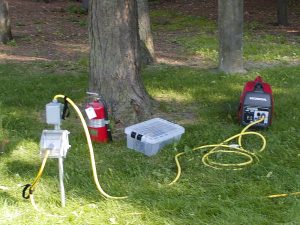
100% Emergency Power bonus applies if all transmitters are on emergency or natural power. Typically this only applies to the transmitters; running lights and computers and the coffee pot on commercial power is usually acceptable. (In most years, a town or agency EOC operating in Class F can also claim this bonus if the EOC has a big enough generator that the town tests on a weekday but won’t let the EOC use for a voluntary ham drill on the weekend.)
Site Visitation – Visits by Elected town officials and/or a representative of a local Served Agency (whom the club or local ARES team has a relationship with) “as a result of an invitation”.
Note that the police patrol does not qualify, unless the patrol officer is also town Emergency Manager, was invited, and is patron recipient of ARES/RACES services. (Alas it specifically says Elected, so hired, professional Town Managers only qualify if there’s a ARES/RACES relationship.)
Also, ARRL Leadership & Staff visits also don’t earn points; we encourage those for reasons other than points!
Safety Officer – You’ll want a Safety Officer anyway, but if they complete the Field Day packet’s Safety Check List, they earn points too!
Public Information Officer / PR
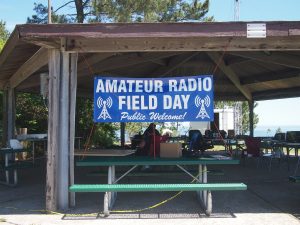
Your Club Public Information Officer (PIO) can provide Public Relations help for Field Day, and can get ARRL handouts through the Section Public Information Coordinator (PIC). See Public Information section for more information. Typically the Government Liaison gets a Proclamation or two; if the Section Manager brings them by, get photos of them at your site!
Public Location (a requirement for Class A operation, bonus also available for B and F) – The intent is for amateur radio to be on display to the public. So be welcoming the public with signs that look inviting. Take photos for both later publicity and to document that it was public.
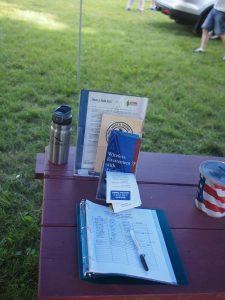
Public Information Table: The purpose is to make appropriate handouts and information available to the visiting public at the site. A copy of a visitor’s log, copies of club handouts or photos of the display and folders is sufficient evidence for claiming this bonus. It’s good to have a club Public Information Officer staffing the table or at least on lookout for wandering public too.
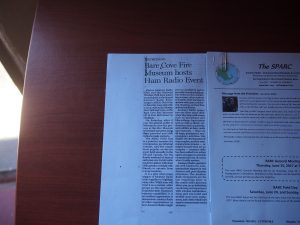
Media Publicity – Getting the announcement of the national Field Day exercise into local press/media is important — so important that attempting it is rewarded. Save a copy of the your press release. Obviously, a clipping or video clip from the news or local TV magazine is even better!
Useful things the PR/PIO team can do to support the above –
- Get Press Release carefully edited — to attract a newspaper or TV News editor’s attention! — and released early for Calendar section lead-times.
- Push message origination at Booth, since it’s good for points (see under NTS heading) as well as public outreach.
- Guided tours
- PR or Central table whiteboard might be used to list States Worked, running tally score, Bonus’s scored, next scheduled event. PR or Central table signboards show what bands are in operations and current & authorized # of TX’s.
- “Public Welcome” sign may need to be BIG if located in a remote corner of a larger parks: some FD sites wind up looking like a private event.
Outreach / Education / Licensing
Clubs often help prospective new hams earn their license with classes and/or VE exams, help hams upgrade by same, and help lapsed hams re-install their gear, renew their license, etc. See also Licensing/Education/Training and Youth sections.
GOTA – Get On The AIr The larger (A and F) stations get one free extra station called GOTA that operates with a second callsign, should they so choose. This station is for non-Ham guest operators to make contacts supervised by a control operator and for Hams to make contacts on bands/modes not within their license with a control operator or not within their usual operating practice or home station capability. The number of contacts per guest operator and points for each varies year to year, so check current rules. The GOTA station must have a GOTA Coach / Control Operator both for legal operation and for the terms of the bonus.
( Guest operators are permissible (with a control operator if not licensed for the band) on the main stations too, once they’ve achieved their GOTA quota, there’s just no specific bonus reward for those contacts. )
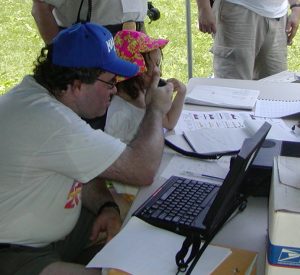
Youth Participation – Youth Participation bonus is per Youth completing one or more contacts, apparently on either the GOTA or main stations. (They may be the control operator of the station or a guest operator.)
Educational / Demonstration – Varies per year – Demonstration of certain modes not eligible for QSO credit has been a bonus in prior years; more recently, a formal “Educational Activity” has been the bonus. See the annual packet for latest details. One local club has a seminar in the classroom of the building they get lights&coffee power from and use the restrooms in; another had a Soldering class.
There hasn’t been a bonus for holding a public VE exam session at Field Day but some clubs do it anyway. Whether that makes sense or not depends on your staffing and facilities! But be sure to invite visitors to classes and exams and exam and class participants to next Field Day, as they can GOTA even before they get licensed. (And if you’re having one, let the EMA FD Directory know, as we list the time each year for you.)
